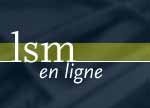Steve Lacy, 1934–2004 Par Marc Chénard
/ 13 juillet 2004
 On June 5, six weeks short of his 70th
birthday, soprano saxophonist Steve Lacy passed away, succumbing to liver
cancer. A native New Yorker, but exiled in France for 32 years, this very
unique musician returned home in 2002 to take on the prestigious chairmanship of
Boston's New England Conservatory. In spite of his all-too-short tenure there,
those close to him claim that he had found the peace of mind that his homeland
finally granted him. On June 5, six weeks short of his 70th
birthday, soprano saxophonist Steve Lacy passed away, succumbing to liver
cancer. A native New Yorker, but exiled in France for 32 years, this very
unique musician returned home in 2002 to take on the prestigious chairmanship of
Boston's New England Conservatory. In spite of his all-too-short tenure there,
those close to him claim that he had found the peace of mind that his homeland
finally granted him.
Few artists in the jazz world have followed as
singular a path as this man: before his 20th birthday, he was fully immersed in
early traditional jazz and had followed in the footsteps of his first influence,
Sidney Béchet, in switching over from clarinet to soprano saxophone. Because of
its tuning problems, few were interested in picking up this horn, at least until
a certain John Coltrane adopted it after having crossed paths with his younger
confrere. More unusual, though, was Lacy's quantum leap from the older stylings
right into the cutting edge of the day, most notably with keyboard mavericks
Cecil Taylor and Thelonious Monk; the latter exerted the single greatest
influence over the saxman's entire career. In fact, he was the first to record a
tribute album to his mentor (1961), and would do so many times thereafter,
including a couple of unaccompanied sides--a medium to which he returned
steadily over the years.
Like many of his American counterparts, he too fled
the increasingly hostile social environment at home, and by the second half of
the 1960s he spent time in Argentina and Italy before finally settling in France
in 1970. Europe was also going through much unrest, and Lacy found an audience
receptive to change and experimentation of all stripes. Before long, he was
crisscrossing the continent as a highly sought after artist, one who was willing
to mix it up with kindred spirits in other countries. Over time, he would
influence a younger generation of players, either by his unique instrumental
sound or his snake-like lines, full of pungent dissonances.
By the mid-1970s, he started to travel back to the
States and tour regularly, even cutting records when opportunity knocked. He
made his first to Montreal visit in 1976, performing a solo saxophone concert
before a full house (an event recorded and released in 2001 by Emanem Records
under the title of Hooky). His last appearance in that city occurred just last
January, when he was invited to direct a workshop concert of local stalwarts of
the improvising music community. Luckily, this concert was preserved by
Radio-Canada before the current dismantling of its program schedule.
In a career spanning half a century, Steve Lacy had
few rivals in terms of recorded output. Even if some considered his music to be
too heady or austere, none can deny its uniqueness. In times when so much hay is
made of fusing things together, Steve Lacy stands out as someone whose interest
lay in taking things apart, in dissecting his own works, not to mention Monk's,
with painstaking and almost obsessive care. Steve Lacy is no more, but his music
merits a place all on its own in the jazz canon.
|
|


